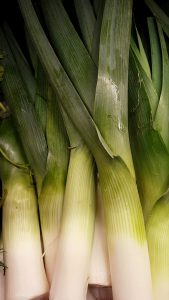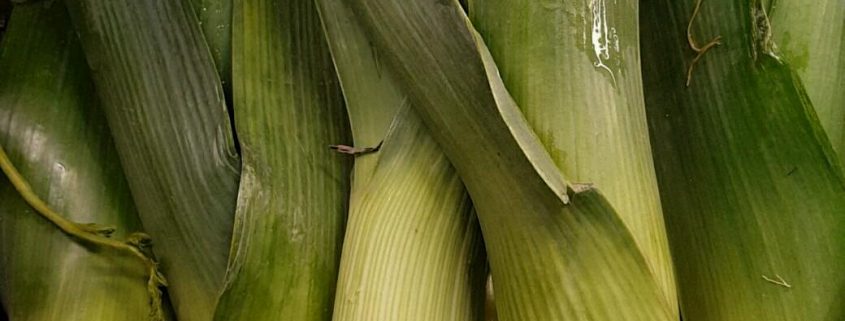All About Leeks
 Did you know that leeks are Wale’s national emblem? The Welsh’s regard for leeks dates back to the 1600s when Welsh soldiers placed leeks in their caps to differentiate themselves from their opponents. To this day, leeks are still an important vegetable in many northern European cultures.
Did you know that leeks are Wale’s national emblem? The Welsh’s regard for leeks dates back to the 1600s when Welsh soldiers placed leeks in their caps to differentiate themselves from their opponents. To this day, leeks are still an important vegetable in many northern European cultures.
Leeks are versatile, tasty, and easy to prepare! They are a member of the allium family with onions and garlic, but have their own distinct flavor.
Health Benefits of Leeks
The health benefits of leeks are less known due to receiving less attention than their fellow allium family members, but that doesn’t mean they don’t have any! One cup of cooked leeks provide some of the following nutrients:
- Vitamin K. Leeks are a great source of vitamin K, which has many important roles in your body. This vitamin plays an essential role in your body’s ability to form blood clots and promote bone health.
- Manganese. This is considered a trace mineral, but the small amount your body needs plays a critical role on your health. Manganese works with vitamin K, vitamin D, and calcium in your bones to promote bone growth. It also plays a role in keeping your skin healthy and strong. Leeks are a good source of manganese.
- Folate. Leeks are often overlooked for their folate content. Unlike most other plants, folate is available throughout the plant instead of solely in the leaves. This distribution makes leeks cardio-protective from top to bottom! Folate play an important role in your brain and nervous system, can lower your cardiovascular risk, and is essential during pregnancy.
- Vitamin B6, copper, iron, and fiber are also found in leeks.
Buy, Store and Prepare
Have you made leeks at home before? I know it can be a little intimidating to try a new vegetable, but here are four tips to keep in mind as you explore cooking with leeks.
- Purchase leeks that are firm and straight with dark green leaves and white necks. Avoid ones that have yellowed or are wilted.
- Wrap leeks loosely in a plastic bag and store in your refrigerator. They keep fresh for one to two weeks.
- Prepare the leeks by trimming off the base and removing the uppermost part of the leaves as those are inedible. Cut into thin strips to shorten cooking time.
- Sauté leeks in olive oil to preserve all their nutrients and enjoy as a side or add them to your salad. You can also add them to broths and strews, or to your favorite omelet or frittata recipe.
When leeks are cooked they taste like a mild onion with a hint of sweetness. They are a versatile vegetable and work well in various recipes!
Exclusive BRG Health Recipes:
Roast Chicken with Apples and Leeks
Crust-less Quiche Muffins with Peas, Leeks, and Ricotta
Leeks are available all year round, but are best between September and March. Try and make them for dinner soon so you can try them at their best!
Your Turn to Take Action: How will you incorporate leeks into dinner this week? Let me know in the comments below!


Leave a Reply
Want to join the discussion?Feel free to contribute!